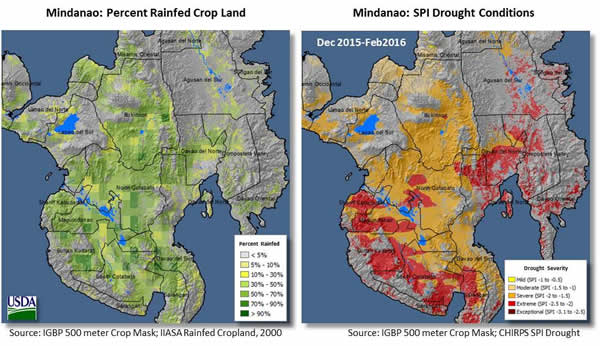PHILIPPINES: Drought in Mindanao Causes Corn Production Decline
Severe to extreme drought conditions are widespread throughout the prime corn growing areas on the island of Mindanao in the southern Philippines. The dryness is the result of a strong El Niño weather pattern that suppressed rainfall over a wide swath of southeastern Asia during 2015 and early 2016. Mindanao is the country’s largest corn producer, averaging about 3.7 million tons or 50 percent of total national production.

Rainfed corn production is concentrated in the central and southern provinces, and is particularly vulnerable to periodic drought. Rainfall over the island was deficient from November 2015 through February 2016, coinciding with the second and third of three annual corn crops. The second and third corn crops are typically sown during the latter part of the summer rainy season from August through November and harvested from December through March. Corn production averages approximately 1.3 million tons during the second and third seasons. Significant rainfall deficits this year caused moisture stress to increase through the late vegetative and reproductive growth phases of the 2015/16 corn crop, reducing yields and causing an earlier than normal harvest.

Total rainfall averaged less than 500 millimeters or between 5 and 50 percent of normal throughout most of Mindanao during the second and third corn growing seasons. The drought severity was especially high in the southwestern provinces making up the region of Soccsksargen (South Cotabato, Cotabato, Sultan Kudarat, Sarangani, and General Santos City). Corn output in Soccsksargen typically totals almost 700,000 tons during the second and third crop seasons, or nearly 54 percent of the island's total crop. Satellite-derived normalized difference vegetation index data (NDVI) from the NASA MODIS satellite indicates that crop vigor is much lower than normal, and that the overall yield potential of crops grown this season is well below normal. The NDVI also confirm that the Soccsksargen and Northern Mindanao regions are expected to be the worst-hit areas.
Drought in Mindanao is expected to cause moderate declines in total corn production during the current USDA 2015/16 marketing year (July 2015 through June 2016). USDA forecasts 2015/16 corn production in the Philippines at 7.5 million tons, down 0.3 million metric tons from last month and down 2.2 percent from last year. Total corn area is estimated at 2.6 million hectares, unchanged from last month but up 1.5 percent from last year. Yield is forecast at 2.88 tons per hectare, down 3.8 percent from last month and down 3.7 percent from last year.

Agricultural lands and crop production in the Philippines are heavily concentrated on the northern island of Luzon and the southern island of Mindanao. Mindanao is the second largest agricultural region in the Philippines, coming close behind the northern island of Luzon in total crop acreage and production of major food grains. Mindanao produces on average 25 percent of the total national rice crop as well as nearly 50 percent of the national corn crop. It is by far the largest corn producing area in the country, accounting for roughly 3.7 million tons of output each year. By comparison, milled rice production in Mindanao typically amounts to approximately 2.6 million tons. The rainy season occurs during the months of Jul through December during Southeast Asia’s monsoon season. The main season corn and rice production occurs at that time. Dry season production, from January through June, is about 30 to 50 percent lower.

Farmers in the Philippines usually plant two rice and corn crops each year, corresponding to the wet and dry seasons. However, in some regions such as Mindanao, farmers attempt to cultivate a third corn crop if weather permits. The second and third crops are usually sown late in the wet season, to take advantage of good moisture during the first 2 to 3 months of the corn life cycle. This year, rainfall from November 2015 through February 2016 was below normal. The USDA 2015/16 marketing year for corn in the Philippines runs from July 2015 through June 2016, which encompasses the wet-season crop followed by the dry-season crop and the potential third-season crop. Corn production in Mindanao is roughly twice as high during the July to December wet season (the first half of the USDA marketing year).

Corn is a primarily rainfed crop which is cultivated on both upland plains and sloping hillsides in Mindanao, with most farmers sowing improved open pollinated varieties and hybrids. The average farm size is quite small at less than 1 hectare, and the majority of the crop (80 to 90 percent) is sold soon after harvest. Corn is typically the main food grain and feed crop cultivated, with the International Maize and Wheat Improvement Center (CIMMYT) reporting that farmers on Mindanao typically allocate between 63 to 85 percent of total cultivated area to the crop. The remainder of their agricultural land is devoted to vegetables, rice, peanut, cotton, and sugarcane. Owing to generally low rainfall and severe drought in many of Mindanao’s primary corn growing areas in 2016, corn production prospects are expected to decline relative to both last year and the 5-year average.
This report has been published by the Office of Global Analysis (OGA), International Production Assessment Division (IPAD). Current USDA area and production estimates for grains and other agricultural commodities are available on IPAD's Agricultural Production page or at PSD Online.
Related Links at FAS
PSD Online
http://apps.fas.usda.gov/psdonline/psdQuery.aspx
Crop Explorer
Crop Explorer http://www.pecad.fas.usda.gov/cropexplorer/
|

